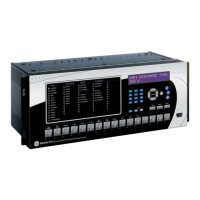CHAPTER 5: SETTINGS GROUPED ELEMENTS
C70 CAPACITOR BANK PROTECTION AND CONTROL SYSTEM – INSTRUCTION MANUAL 5-229
5
BF1 TIMER 3 PICKUP DELAY — Timer 3 is set to the same interval as timer 2, plus an increased safety margin. Because this
path is intended to operate only for low level faults, the delay can be in the order of 300 to 500 ms.
BF1 BKR POS1 φA/3P — This setting selects the FlexLogic operand that represents the protected breaker early-type auxiliary
switch contact (52/a). When using the single-pole breaker failure scheme, this operand represents the protected breaker
early-type auxiliary switch contact on pole A. This is normally a non-multiplied form-A contact. The contact can even be
adjusted to have the shortest possible operating time.
BF1 BKR POS2 φA/3P — This setting selects the FlexLogic operand that represents the breaker normal-type auxiliary switch
contact (52/a). When using the single-pole breaker failure scheme, this operand represents the protected breaker auxiliary
switch contact on pole A. This can be a multiplied contact.
BF1 BREAKER TEST ON — This setting is used to select the FlexLogic operand that represents the breaker in-service/out-of-
service switch set to the out-of-service position.
BF1 PH AMP HISET PICKUP — This setting sets the phase current output supervision level. Generally this setting is to detect
the lowest expected fault current on the protected breaker, before a breaker opening resistor is inserted.
BF1 N AMP HISET PICKUP — This setting sets the neutral current output supervision level. Generally this setting is to detect
the lowest expected fault current on the protected breaker, before a breaker opening resistor is inserted. Neutral current
supervision is used only in the three pole scheme to provide increased sensitivity. This setting is valid only for three-pole
breaker failure schemes.
BF1 PH AMP LOSET PICKUP — This setting sets the phase current output supervision level. Generally this setting is to detect
the lowest expected fault current on the protected breaker, after a breaker opening resistor is inserted (approximately 90%
of the resistor current).
BF1 N AMP LOSET PICKUP — This setting sets the neutral current output supervision level. Generally this setting is to detect
the lowest expected fault current on the protected breaker, after a breaker opening resistor is inserted (approximately 90%
of the resistor current). This setting is valid only for three-pole breaker failure schemes.
BF1 LOSET TIME DELAY — Sets the pickup delay for current detection after opening resistor insertion.
BF1 TRIP DROPOUT DELAY — This setting is used to set the period of time for which the trip output is sealed-in. This timer
must be coordinated with the automatic reclosing scheme of the failed breaker, to which the breaker failure element sends
a cancel reclosure signal. Reclosure of a remote breaker can also be prevented by holding a transfer trip signal on longer
than the reclaim time.
BF1 PH A INITIATE / BF1 PH B INITIATE / BF 1 PH C INITIATE — These settings select the FlexLogic operand to initiate phase A, B,
or C single-pole tripping of the breaker and the phase A, B, or C portion of the scheme, accordingly. This setting is only valid
for single-pole breaker failure schemes.
BF1 BKR POS1 φB / BF1 BKR POS 1 φC — These settings select the FlexLogic operand to represents the protected breaker
early-type auxiliary switch contact on poles B or C, accordingly. This contact is normally a non-multiplied Form-A contact.
The contact can even be adjusted to have the shortest possible operating time. This setting is valid only for single-pole
breaker failure schemes.
BF1 BKR POS2 φB — Selects the FlexLogic operand that represents the protected breaker normal-type auxiliary switch
contact on pole B (52/a). This can be a multiplied contact. This setting is valid only for single-pole breaker failure schemes.
BF1 BKR POS2 φC — This setting selects the FlexLogic operand that represents the protected breaker normal-type auxiliary
switch contact on pole C (52/a). This can be a multiplied contact. For single-pole operation, the scheme has the same
overall general concept except that it provides re-tripping of each single pole of the protected breaker. The approach
shown in the following single pole tripping diagram uses the initiating information to determine which pole is supposed to
trip. The logic is segregated on a per-pole basis. The overcurrent detectors have ganged settings. This setting is valid only
for single-pole breaker failure schemes.
Upon operation of the breaker failure element for a single pole trip command, a three-pole trip command needs to be
given via output operand BKR FAIL 1 TRIP OP.

